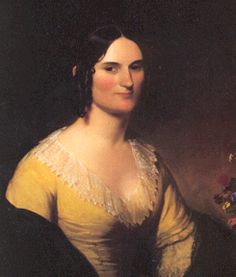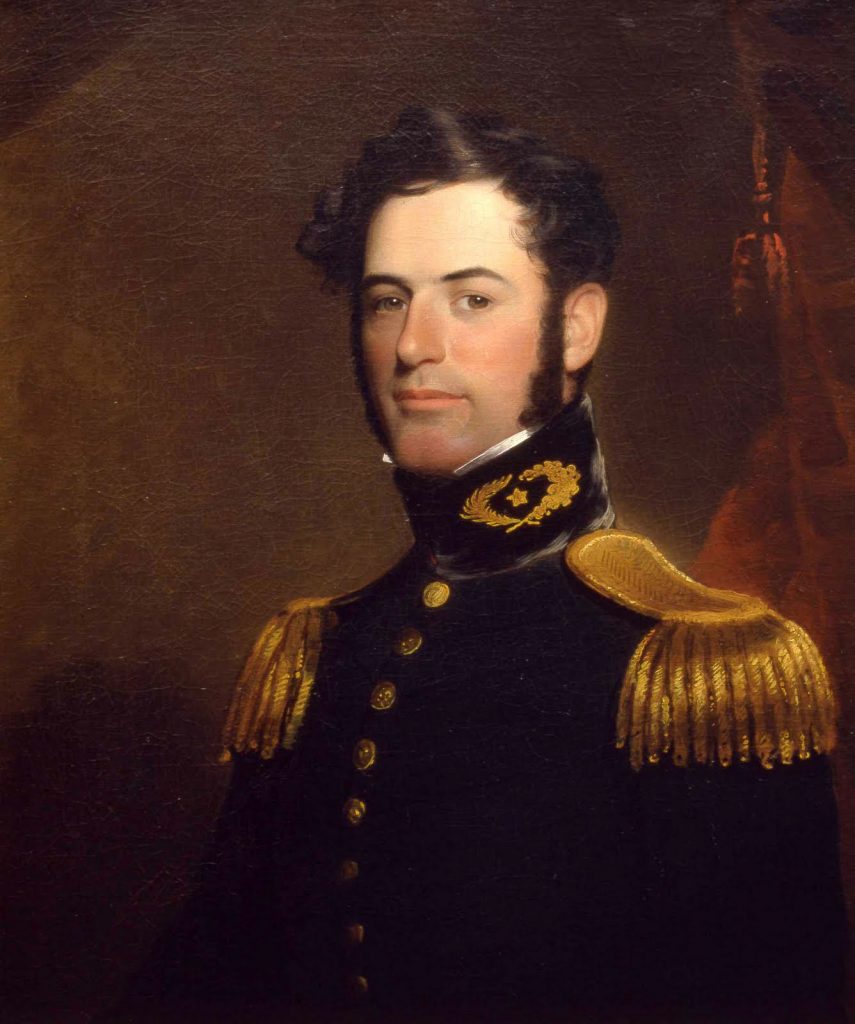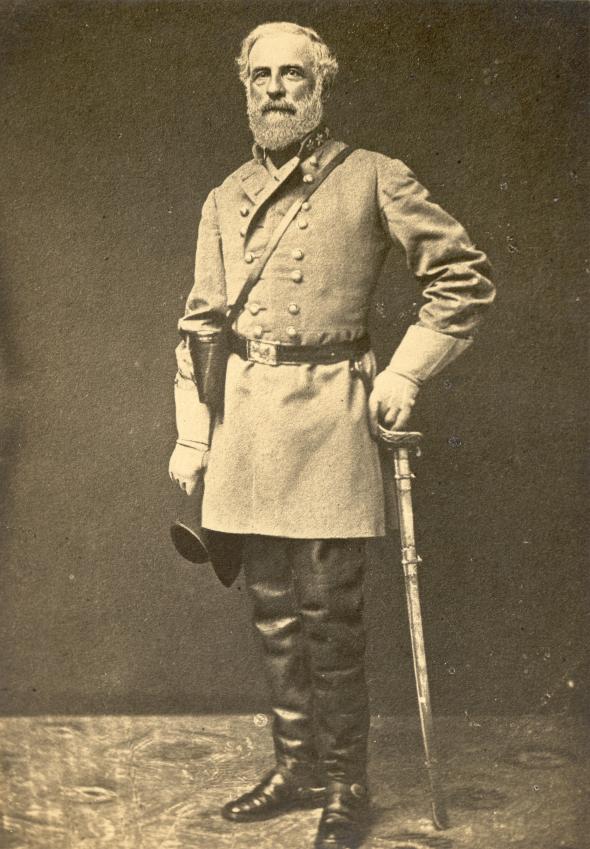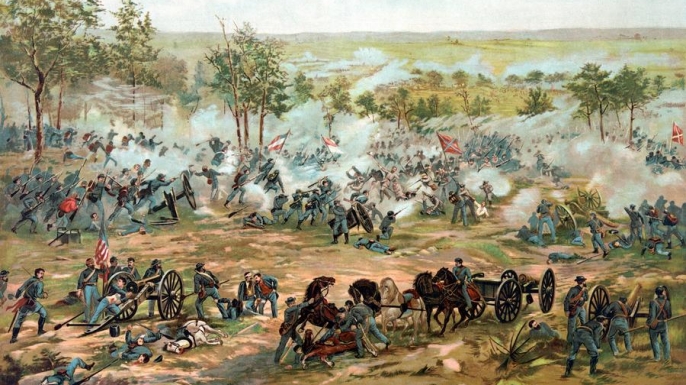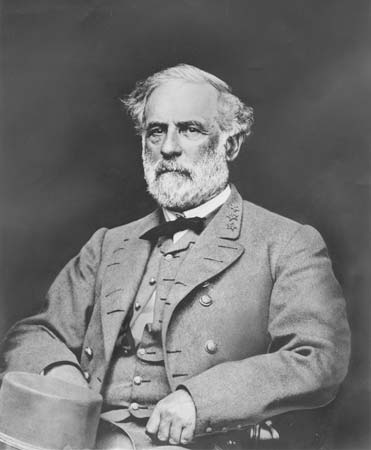Robert E. Lee was the general of the Confederate Army during the infamous American Civil War. He first served in the American Army as a colonel from 1829 until the war broke out in 1861. Lee’s father was a plantation and slave owner himself, though evidence suggests that Lee was actually opposed to slavery, despite fighting for the South.
On January 19, 1807 (possibly 1806) Robert Edward Lee was born in Stratford Hall, Virginia to Henry ‘Light-Horse Harry” Lee and Anne Hill Carter. Henry Lee had previously had three children with his first wife, then six with Anne Hill Carter, Robert being their fifth. Lee was young when Henry Lee abandoned his family and fled to the West Indies after a political dispute. His mother, left alone to raise six young children, would often take the family to stay with relatives and friends for long amounts of time. When Lee was eleven, his father had passed away in the West Indies. He attended two schools growing up: Eastern View located in Fauquier County for young boys and Alexandria Academy, another school for boys. Lee was noted to be skilled when it came to mathematics.
William Henry Fitzhugh, a relative of Anne Lee’s, helped the Lee family out after Henry Lee left. The Lee’s stayed with Fitzhugh at his home in Fairfax County, Ravensworth often. When Robert Lee was seventeen, Fitzhugh wrote a letter to John C. Calhoun, United States Secretary of War, recommending that he appoint the young Lee into the United States Military Academy at West Point. Soon, Lee was sent a letter in March of 1824 stating that though he would have to wait another year to begin at the school, he had been accepted.
Eighteen-year old Lee began at West Point in the summer of 1825. Just behind Charles Mason, who went on to become an attorney after resigning from the army a year later, Lee graduated second in his class. During his time at West Point, the main focus at the school was engineering. Shortly after graduating, Lee was commissioned as a brevet second lieutenant in the Corps of Engineers in 1829. Before being assigned to a post, Lee made his way back home to Virginia for some time. However, when he returned, he found his mother dying. On July 26, 1829, Anne Hill Carter Lee died.
Not long after the passing of his mother, Lee was assigned to Cockspur Island, Georgia on August 11, 1829 by Brigadier General Charles Gratiot. Lee was apart of the plan to have a fort built on the island, but it did not go as planned and he was moved to Fort Monroe in what is today known as Hampton, Virginia.
While Lee had been back home that summer, he was said to have courted Mary Custis, Martha Washington’s great-granddaughter and George Washington’s step-great-granddaughter. The two began corresponding once he left for Georgia, though they made sure to keep their letters discreet because her mother went through all of them. After denying his first proposal because of her father, Mary finally accepted in September of 1830. On June 30, 1831, the couple married at her family home in Arlington. Together, they had seven children: George Washington Custis (1832-1913), Mary Custis (1835-1918), William Henry Fitzhugh (1837-91), Anne Carter (1839-62), Eleanor Agnes (1841-73), Robert Edward Lee, Jr. (1843-1914), and Mildred Childe Lee (1846-1905). Mary accompanied him to Hampton Roads after their marriage, and their first son had been born while she was with Lee at Fort Monroe.
The War Department transferred all their engineers out of Fort Monroe, only leaving Lee behind to live on the artificial island Rip Raps across from the fort. In 1834, Lee was transferred once more, this time to be General Gratiot’s assistant in Washington. He hoped that he could find a house to rent so he could reside with his family in Washington, but was unsuccessful. So, his family stated at the Arlington estate. During winter, Lee often rented a room at a boarding house so he would not have to travel daily. Then, in 1835, Lee was assigned to survey the southern border of Michigan with Andrew Talcott. His wife had fallen ill, and begged him to return home, but he was unable to until he finished his post. Lee returned home as soon as he was done, and found that Mary, bedridden and ill, had just given birth to their daughter, Mary Custis Lee.
During the summer of 1835, Lee worked to help lay out the Ohio-Michigan state lines. The following year in October, Lee was given the rank of first lieutenant. With his new position, Lee supervised engineering work that had been going on at St. Louis harbor and the upper areas of the Mississippi and Missouri rivers. He also mapped out the Des Moines Rapids. Because of his hard work, Lee was promoted to a captain. Sometime around 1842, Lee was assigned as an an engineer at Fort Hamilton.
Lee was one of the chief aides of Winfield Scott during the Mexican-American War in 1846-48. He proved to be very clever and helpful during the war, finding undefended areas to attack and taking part in many victories. Following the Battle of Cerro Gordo on April 18, 1847, Lee was promoted to brevet major. He continued to fight in the war, taking part at Contreras and Churubusco, then suffering through a minor injury after Chapultepec. Lee met Ulysses S. Grant and the two participated in the march Scott led from Veracruz to Mexico City. The war ended on February 2, 1848 after Lee had received a few brevet promotions before becoming Lieutenant Colonel, and then Colonel.
For three years, Lee spent time in Baltimore harbor at Fort Carroll. He also surveyed and updated Floridian maps, among other things. Jefferson Davis was originally asked by Narciso López to liberate Cuba from the Spanish, but Davis declined and recommended Lee, who was unable to do it. In 1857, following the death of George Washington Parke Custis, Mary’s father, Lee executed the estate, and him and Mary also inherited it. After five years, they had to free all of Custis’s slaves due to his orders in his will. When the Civil War broke out, the Lee family was forced to flee from the Arlington estate. Before the Civil War, he participated in two of the main events that led to the war, Harpers Ferry and the secession of Texas.
When the war was first beginning, Lee stated that he did not want a war, and it would not be smart for the United States to break into the Confederacy and the Union. On April 20, 1861, Lee resigned from the U.S. Army after being promoted to a colonel on March 28. Three days later, he took command of the Virginia state forces. Mary favored the Union, so it must have been a surprise when Lee, despite most likely being opposed to slavery, joined the Confederates. He was one of the Confederate States of America’s first five full generals but refused to even wear the insignia of a Confederate general. For his first assignment, Lee commanded the Confederate forces located in Western Virginia, and was defeated at the Battle of Cheat Mountain. Many blamed him for being the cause of Confederate setbacks.
On November 5, 1861, Lee was appointed commander of the coastal defenses in Carolina and Georgia. He was able to successfully block advances on Savannah by putting in a defense system on April 11, 1862. He continued to strengthen defenses on Fort Pulaski and Fort Jackson. Savannah stayed well defended until the war was nearly over in 1864. Jefferson Davis, the Confederate President, appointed him as his military adviser. Lee also began digging trenches around the capitol, earning him the nickname “King of Spades”. The trenches, despite being ridiculed, would come into play towards the end of the war.
Lee took control of the Army of Northern Virginia when Gen. Joseph E. Johnston had been injured at the Battle of Seven Pines in June of 1862. His men gave him the nickname “Granny Lee” because he was slower to attack and approach Union forces. Even many newspapers said that he was too slow to attack to really control the army. During the spring of 1862, Lee launched the Seven Days Battles that resulted in terrible casualties on both sides, but higher for the Confederates. However, these attacks did lead Union leader George B. McClellan to abandon the Peninsula Campaign. Lee was then called “Marse Robert” by his men instead of the much worse earlier nickname. This new one showed they respected him.
At the Second Battle of Bull Run, Lee defeated the Union army. Already with only being at his position for ninety days, had been quite successful. Next, they set to invading Maryland. Union officers were able to find the lost order which revealed Lee’s plans, but McClellan was too slow and was defeated by Lee once again.
Abraham Lincoln found out about Lee’s defeat against McClellan and Ambrose Burnside was named commander of the Army of the Potomac. Burnside launched an attack in Fredericksburg, which resulted in a victory for the Confederates. Lee continued to strengthen his army, and when the Union tried to lead an assault on December 13, 1862, Lee and his men won. Joseph Hooker was soon named commander of the Army of the Potomac because Abraham Lincoln was disappointed at the union defeat under Burnside’s command. The Union suffered another loss at the Battle of Chancellorsville. Lee faced many casualties, including one of his best officers, Stonewall Jackson, but nevertheless, still defeated the Union.
When marching towards the North, Lee and his men encountered George G. Meade’s Union forces, and the Battle of Gettysburg began. It is perhaps one of the most famous Civil War battles to this day, with more casualties than any other battles during the war. After three days, the Union won the battle after Lee retreated due to losing so many of his men. Lee had tried to resign after the disastrous battle, but President Jefferson Davis would not allow it.
Ulysses S. Grant was soon named the new Union general-in-chief in 1864. That May, the Battle of the Wilderness and the Battle of Spotsylvania were fought with inconclusive results.
Lee’s numbers were only continuing to drop. They won the Battles of Cold Harbor and Fussell’s Mill that summer, but were defeated during the Appomattox Campaign the following March. Before, Lee had been promoted to Confederate general-in-chief of January 31, 1865, though the American Civil War ended that year on May 9, 1865 with the Union winning.
Once the war was finally over, Lee lost his rights to vote and some of his property, but was never arrested or badly punished. He made his opinion clear that blacks should be allowed to attend schools, but should not have the right to vote. When he accepted President Grant’s offer to visit the White House in 1869, many saw him as a symbol of reconciliation between the Northern and Southern states. Lee and his wife had wanted to retire to their own farm, but were unable to because of his popularity. So, they lived in Richmond, Virginia at the Stewart-Lee House for some time before moving to Lexington. There, Lee was Washington College’s (today it is known as Washington and Lee University) president from October 1865, until his death in 1870. While there, he once even told one of his colleagues that his biggest mistake in life was attending a military academy. Lee stayed active in politics until his death.
Lee suffered through a bad stroke on September 28, 1870 that resulted to his death of pneumonia on October 12, 1870 while in Lexington. Robert E. Lee was buried at Lee Chapel, Lexington, Virginia.



